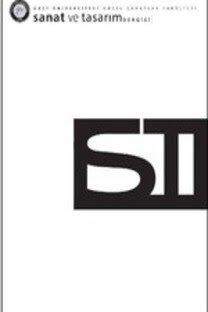Tekinsiz ve İğrenç: Hiperreal Figür Heykelleri ve Alışılmadık Vücutlar İçin Bir Okuma Önerisi
Bu makalede son dönem heykelinde yeniden doğuşuna şahit olduğumuz figürün hangi kavramlarla okunabileceği üzerinde durulmuştur. Metinde figürden kastedilen insan bedenidir. Günümüzde figür heykelinde farklı tutum ve eğilimler bir arada görülmektedir ancak metinde hiperreal ve vücudun alışılmadık hallerde sunulduğu heykeller ele alınmıştır. Örnek olarak 2014 yılına yakın zamanlara tarihlenen heykel çalışmaları incelenmiştir. Varılan sonuç şudur: Figürün yerini malzemesiyle, dokusuyla, ölçeğiyle, insan bedenine neredeyse gözle ayrılamayacak derecede yakın bir görünüm almıştır, diğer bir deyişle heykelde figür vücutlaşmıştır. Son dönem heykelinde vücudun aşırı gerçekçi ve tuhaf hallerde tasviri iki kavramı beraberinde getirmektedir. Bu kavramlardan birincisi Sigmund Freud’un tekinsiz –the uncanny- kavramı, ikincisi Julia Kristeva’nın iğrenç –the abject- kavramıdır. Yazı kapsamında güncel heykelde figürün, seçilen örnekler üzerinden bahsedilen iki kavramla okuma denemeleri yapılmıştır.
Anahtar Kelimeler:
Figür, Beden, Tekinsiz, İğrenç, Güncel Heykel
Uncanny and Abject: A Proposal in order to Read Hyperreal Figure Sculptures and Weird Bodies
This article is based on the concepts along with we can interpret reinvented figure sculpture of today. In the text figure means human body. In recent sculpture art there are different tendencies seen together yet within the lense of the article hiperreal sculptures and human bodies depicted in strange conditions were discussed. Examples were chosen between the works dated nearby 2013. The result is this: Figure is replaced by a very close appearance to human body with its material, texture, scale. In other words figure in sculpture is becoming body. Hyperrealist depiction of human body in recent period’s sculpture connotes two concepts. The first one is Freud’s concept of “Uncanny” and the second one is Julia Kristeva’s concept of “Abject”. Within the scope of this article it is tried to be interpreted figure in contemporary sculpture by these two above mentioned concepts.
Keywords:
Figure, Body, Uncanny, Abject, Contemporary Sculpture,
___
- ADAMSON Glenn. (2007) Thinking Through Craft. Berg Publishers: Oxford-New York.
- APA Melih (KIŞ:2002). “Üzerinde Konuşulan, Okunan ve Görülen Bir Heykel”, Sanat Dünyamız. Sayı:82, YKY, İstanbul, Sayfa:133-137
- BOIS, Y., BUCHLOCH, Benjamin,. FOSTER, H., KRAUSS, R. (2004) Art Since 1900 Modernism Antimodernism Postmo- dernism. Thames&Hudson: London.
- COLLINS Judith. (ed.) (2007) Sculpture Today. Paidon Press: New York.
- EVRENOL Can. Fantastik Sinemada Psikoanalitik Kavramlar. http://www.otekisinema.com/fantastik-sinemada-psikoanalitik-kavramlar/ (erişim tarihi: 27 mart 2013)
- GOMBRICH, E. H. (1997) Sanatın Öyküsü ( Çev. Erol Erduran, Ömer Erduran), Remzi Kitabevi:İstanbul.
- KRISTEVA Julia. (2004) Korkunun Güçleri: İğrençlik Üzerine Deneme. (Çev. Nilgün Tutal), Ayrıntı Yayınları: İstanbul.
- PENNY Evan.
- http://evanpenny.com/contact.php (erişim tarihi 5 Mart 2014)
- POTTS Alex. (1992) “Male Phantasy and Modern Sculpture”. Oxford Art Journal, Vol. 15, No. 2 Sayfa:38-47 http://www.jsot.org/stable/1360499 (erişim tarihi 15 Mart 2013)
- QUINODOZO, Jean Michel. (2004) Reading Freud A Chronological Exploration of Freud’s Writings. Routledge: London.
- ROBERTSON J., McDANIEL C. (2010) Themes of Contemporary Art: Visual Art After 1980. Oxford University Pres: New York.
- Sculpture From Antiquity to the Middle Ages 1 (2006) Hazırlayan: Georges Duby ve Jean-Luc Daval, Taschen, London.
- SIGMUND Freud. Uncanny, 1919. http://web.mit.edu/allanmc/www/freud1.pdf (erişim tarihi 22 Nisan 2013)
- TURANİ, Adnan. (1979) Dünya Sanat Tarihi. Türkiye İş Bankası Yayınları: Ankara.
- ISSN: 1308-2264
- Yayın Aralığı: 2
- Başlangıç: 2015
- Yayıncı: Ankara Hacı Bayram Veli Üniversitesi
Sayıdaki Diğer Makaleler
Küresel İklim Değişikliğinin Toplumsal Algısında Görsel Sanatların Rolü
Kolektifliğin Varoluşsal Mimarlığı: Dessau Törten Konutlarına Görüngübilimsel Bir Yaklaşım
Sanat ve Bilimin Kesişiminde Bir Yerleştirme Sanatçısı: James Turrell
Tekinsiz ve İğrenç: Hiperreal Figür Heykelleri ve Alışılmadık Vücutlar İçin Bir Okuma Önerisi
